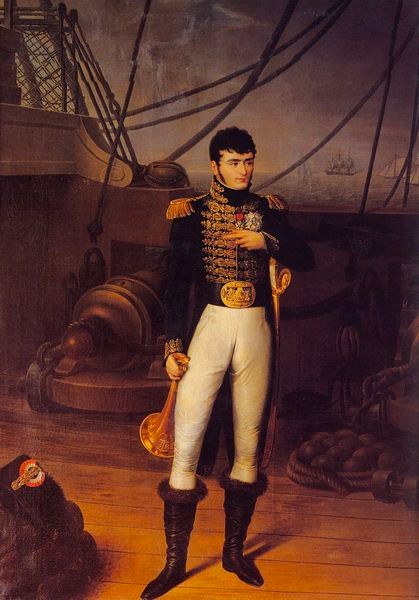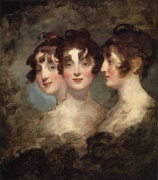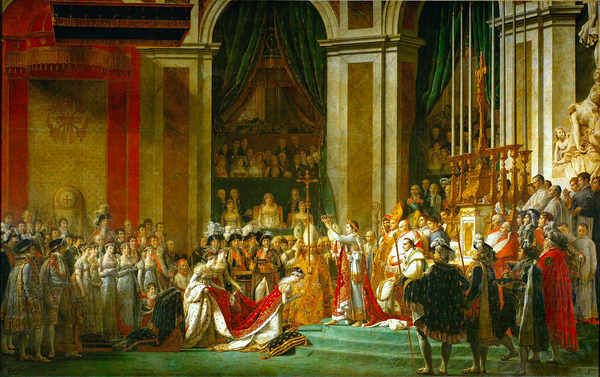If the FBI had existed in 1803, Napoleon’s troublemaking little brother Jerome Bonaparte certainly would have rated a file, especially after he began romancing Baltimore belle Elizabeth Patterson, one of the wealthiest girls in the U.S. Surprisingly, this spicy Bonaparte love affair ultimately led to the creation of the world’s most famous bureau.
Portrait of Jerome Bonaparte on the Bridge of a Ship. Circa 1805-1806. Source.
Jerome’s Privileged Youth in the Royal Palace of ParisWhen Napoleon Bonaparte became leader of France in 1799, he promptly moved into the Tuileries, the Paris palace long inhabited by French kings, and invited his little brother, Jerome, to live with him and his wife, Josephine. Napoleon quickly had reason to regret his hospitality.
The Tuileries had belonged to the royal house of France since it was built for Catherine de Medici in 1564, directly in front of the Louvre. The palace was destroyed in 1871. Painting circa 1757. Source.
Frequently away from Paris on business and battles, Napoleon, then the First Consul, kept returning home to discover that foppish Jerome, addicted to fashion at age 15, had run up debts all over town. He bought the most fashionable boots and most stylish jackets and dined at the priciest restaurants in Paris, drinking the finest wines. What’s more, he’d racked up jaw-dropping bills for shaving sets made of gold, even though Jerome didn’t yet shave, as well as antique tobacco jars once belonging to King Louis XIV, even though Jerome didn’t smoke.
In the NavyHoping to instill discipline in the vice-prone spendthrift, Napoleon finally enlisted Jerome in the French Navy. However, Jerome kept getting bored, cutting short his service whenever he wished, and borrowing money from the commanding officer on board, making his way back to Paris to have tailors make him personally stylized uniforms — billed to Napoleon — and to wine and dine his many lady friends.
In 1802, Napoleon sent Jerome (for the second time) to what is today’s Haiti. His little brother was to take part in a secret operation that Napoleon was planning — to invade North America, take control of the Mississippi River and extend France into what is now America’s Midwest. That mission failed, however, when mosquitoes carrying yellow fever killed half of the 20,000 French troops sent to Saint Domingue. Strangely, Napoleon's brother was not counted among the living or the dead.
Love American Style Months before, Jerome had gone AWOL from the French Navy — hopping a U.S. frigate to Virginia in July 1802. Promptly making his way to the French embassy in Washington, DC, he borrowed what today would be over $500,000 from the French ambassador — and then set out to see the sights.
In Baltimore, Jerome made the acquaintance of Elizabeth Patterson, the beautiful daughter of shipping magnate William Patterson, the second-wealthiest man in the U.S. Handily, Elizabeth spoke French, being an ardent Francophile, even though she hadn’t yet visited Europe. She was easily charmed by Jerome’s swagger and buttery accent, falling head-over-heels for the handsome Bonaparte who wooed her and quickly asked for her hand in marriage.
Triple Portrait of Elizabeth Patterson Bonaparte painted by Gilbert Stuart in 1804 shortly after she wed Jerome. Metropolitan Museum of Art. Source.
Elizabeth’s father did not favor the idea of his daughter marrying a Frenchman, a Bonaparte at that — and the French ambassador didn’t endorse the plan either. Elizabeth was madly in love, however, and stated that she’d rather be married to Jerome for a mere hour than to another man for a lifetime. When the ambassador wrote to Napoleon about the courtship, the First Consul forbid Jerome from marrying her.
The Forbidden Wedding Goes ThroughOn December 24, 1803, the young couple — both 18 years old — were married in Baltimore. Their outfits alone struck awe in all who attended: Jerome looked dashing in his suit made of the finest purple silk, his belt gleaming with diamonds. The lovely bride was clad in a simple dress of muslin with pearls, the dress being so sheer, noted shocked attendees, that one could see her undergarments.
In February 1804, when Napoleon, who’d just sent an emissary to the United States to retrieve his wayward brother and yank him back to France, learned that Jerome had married Elizabeth, he was furious. He had wanted Jerome to marry into European royalty and strengthen French political alliances. Napoleon demanded that the pope — and President Thomas Jefferson — annul the marriage, but both ignored his demand.
 After Theodosia Burr Alston, the daughter of former vice president Aaron Burr, insisted that the newlyweds see it, the new Mr. and Mrs. Jerome Bonaparte explored Niagara Falls in early 1804, making it a honeymoon hot spot. Painting by Frederic Edwin Church. Circa 1844. Source.
After Theodosia Burr Alston, the daughter of former vice president Aaron Burr, insisted that the newlyweds see it, the new Mr. and Mrs. Jerome Bonaparte explored Niagara Falls in early 1804, making it a honeymoon hot spot. Painting by Frederic Edwin Church. Circa 1844. Source.
Jerome and Elizabeth honeymooned for weeks, including in Niagara Falls. Learning that Napoleon had proclaimed himself emperor of France in May, the couple decided to set sail for France to partake in the lavish imperial coronation scheduled for December.
Sinking Ships Marking an end to newlywed bliss, the first ship the couple boarded was turned back by the British. The second vessel soon ran into a violent storm and sank — taking all their gold, art, fine clothes and wedding presents with it. Elizabeth and Jerome made it back to shore in a lifeboat.
When Jerome didn’t show up for his imperial coronation, the once-in-a-lifetime spectacular show, Napoleon wasn’t at all pleased: he removed Jerome from the rulers-to-be list he was making of his siblings.
When Jerome missed the 1804 Coronation of Emperor Napoleon, captured here in a painting by Jacques-Louis David, his brother was livid. Source.
Even though Mr. and Mrs. Jerome Bonaparte had missed Napoleon’s coronation, Elizabeth — now five months pregnant — longed to see France for the first time. Finally, in March 1805, her father sent them on one of his ships bound for Portugal.
Shocking NewsWhen the vessel dropped anchor in Lisbon, customs agents notified the couple that Napoleon had annulled their marriage. Jerome had been summoned to meet his brother, but Elizabeth was not allowed to disembark. Shocked, Jerome vowed that he would do everything that needed to be done to fix the problem, and galloped off.
The ship carrying Elizabeth headed to Holland, but there, too, she was prevented from disembarking. Finally, in May, she was allowed off the vessel in London — requiring government escorts because so many had gathered to see the new Mrs. Jerome Bonaparte. While still awaiting word from Jerome, she gave birth to their son, Jerome Napoleon Bonaparte II, in early July 1805.
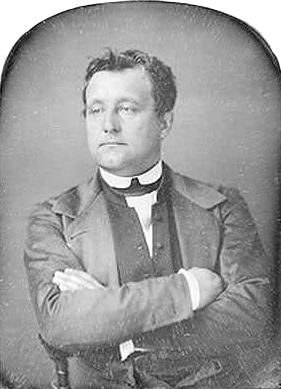 Daguerreotype of Jerome “Bo” Napoleon Patterson-Bonaparte (1805-1870). Circa 1850. Source.
Daguerreotype of Jerome “Bo” Napoleon Patterson-Bonaparte (1805-1870). Circa 1850. Source.
That fall, still unable to enter France, she returned to Baltimore with her baby — sporadically receiving letters from her husband filled with vague promises of unending love. In 1807, Elizabeth learned that a notice of divorce had been filed in Paris and in May her husband had married Princess Catharina of Wurttemberg, daughter of King Frederick. As a symbol of their rekindled fraternal bond, Napoleon had made Jerome a king of the newly conquered German territory called Westphalia.
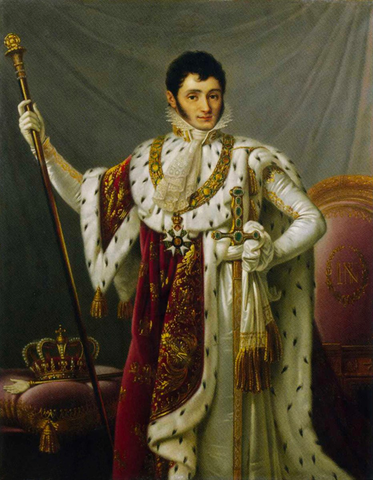 Jérôme-Napoléon Bonaparte, King of Westphalia. Circa 1810. Source.
Jérôme-Napoléon Bonaparte, King of Westphalia. Circa 1810. Source.
Jerome had not forgotten his first love though, and he invited Elizabeth to move to Westphalia with their son, promising to make her a princess of a nearby township. As a woman of principle, she declined. Napoleon, however, began sending her an annual pension, which she used to buy real estate, ultimately making a fortune.
Finally Setting Foot on the ContinentIn 1815, when Napoleon was finally defeated and exiled to St. Helena, Elizabeth and her 10-year-old son, “Bo,” set sail for Europe. This time she was allowed to disembark and she soon made a name for herself across European high society, becoming a star at the Parisian balls. Eventually traveling to Italy, where Napoleon’s siblings lived since they’d been banished from France, she even befriended Jerome’s family, though Elizabeth never once met up with Jerome.
Jerome’s unexpected departure in Lisbon was the last time Elizabeth set eyes on her husband. However, Jerome once set eyes on Elizabeth — in Florence. One afternoon at the Pitti Palace, where Jerome, who lived nearby, was strolling with his second wife, he caught sight of Elizabeth. “There’s my American wife!” he said to Catharina — and they hightailed it out.
Elizabeth lived for years in Europe, and Bo traveled back and forth since his grandfather wanted him back in the States. At age 21, Bo for the first time met his father, Jerome – even staying with him for a summer in Italy. Bo wrote to his grandfather that while Jerome and his family were kind, their lifestyle seemed empty, meaningless and idle.
 Jerome, as King of Westphalia from 1807 to 1813, adored the costumes that came with the job. After Napoleon fell, Jerome didn’t do much and did not dress as well. Source.
Jerome, as King of Westphalia from 1807 to 1813, adored the costumes that came with the job. After Napoleon fell, Jerome didn’t do much and did not dress as well. Source.
Though Elizabeth wanted Bo to marry his French cousin Charlotte — the daughter of Napoleon’s brother, Joseph — Bo instead returned to Baltimore. Elizabeth was furious when he opted instead to marry a wealthy American woman whose family had started the country’s first railroad, B&O. In an oddly repetitive fashion, Bo didn’t even invite his mother to his wedding, and she found out about his marriage after the fact.
Jerome Napoleon Patterson Bonaparte wed Susan May William in 1929. The bride’s dowry was substantial and Bo’s grandfather threw in a mansion as a wedding present. Their union resulted in two boys. The eldest, named Jerome Napoleon Bonaparte II, graduated from West Point in 1852 — and went to fight for France.
The Empire ReturnsIn 1852, Louis-Napoleon, the son of Napoleon’s brother, Louis, had surprisingly claimed the French imperial throne — and started the Second French Empire. Jerome, by then the only surviving sibling of Napoleon, was happy to partake in the new rule of his nephew Louis-Napoleon, who called himself Napoleon III.
The emperor showered Jerome with new titles including Marshal of France, President of the Senate and Governor of Les Invalides. He also put Jerome’s two surviving children from his second marriage — Mathilde and Plon-Plon — on the civil list, making them powerful personalities in the Second Empire.
Faux Bonapartes, True Americans
 Jerome’s youngest grandson, Charles Bonaparte (1851-1921), created the FBI in 1908. Source.
Jerome’s youngest grandson, Charles Bonaparte (1851-1921), created the FBI in 1908. Source.
However, Napoleon III decided not to recognize Bo, or his son, as true Bonaparte heirs. They were instead known as Patterson-Bonapartes. When Jerome died in 1860, they were not mentioned in the will. Nevertheless, Jerome’s grandson continued to fight as an officer for the emperor throughout his reign, leaving only after the Second Empire crashed in 1870. He returned to live in the U.S., where Elizabeth had set up her final residence in Baltimore, living there until her death in 1879.
Meanwhile, Jerome’s other grandson, Charles Bonaparte – whom he never met — was climbing the ranks in the government of U.S. President Theodore Roosevelt. First made Secretary of the Navy in 1905, he became U.S. Attorney General the next year, earning a reputation as a trust-buster. As attorney general, Charles Bonaparte in 1908 created the Bureau of Information, which became known as the Federal Bureau of Investigation — the agency that certainly would have had his sweet-talking Bonaparte grandfather in its sights, had it been around back when bad boy Jerome showed up in Baltimore in 1803.
